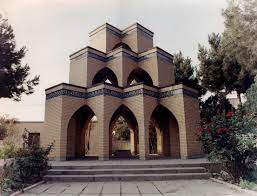Kamāl al-Dīn Ḥusayn ibn ʿAlī Kashifi
Kamāl al-Dīn Ḥusayn ibn ʿAlī Kashifi | |
|---|---|
 A memorial in his birthtown, Sabzevar | |
| Born | 840 AH Sabzevar |
| Occupation | Author |
Kamāl al-Dīn Ḥusayn ibn ʿAlī Kashifi (َArabic : کمال الدین حسین بن علی کاشفی) is a Persian Muslim scholar, poet, writer, influential preacher and moralist, also known as Mawlana Vaiz Kashifi or simply Mullah Hussein.
Biography[edit | edit source]
Kamāl al-Dīn Ḥusayn ibn ʿAlī Kashifi was born in Sabzevar, a city in the province of Bayhaq in 840 AH. He had spent some of his life time in his hometown of Sebzevar as a preacher then he moved to Nishapur for better facilities and then Mashhad. In 1456, he moved to Harat in order to know and learn about Sufi vision. Soon after , he got influenced by the great Persian Poet, Abdurrahman Jami, the successor to Kashgari. Then, he returned to his hometown, Sabzevar.
The historian Khondamir informs us that Kashifi was well versed in astrology and epistolography, and adds that as an interpreter of the Qur'an No one equaled him in terms of expertise in Khorasan at that time. He was a remarkable writer and a poet who signed poetry under the pseudonym (tahallus) "Kashifi" (which means "revealing", "revealing").
Kashifi remained in Harat until his death in 910 AH.
Honors and activities[edit | edit source]
- Patronized at the highest level - Sultan Hussein Baykar himself
- Served as an Influential courtier, vizier of the Sultan
- Dedicated several of his works to Outstanding poet Alisher Navoi
- Had series of speaches on Friday mornings, on other days - in the cathedral mosque of Herat, in the Sultan madrasah and in places of worship of Muslim saints
Works and books[edit | edit source]
- Akhlaq-e Moheseni (Persian: اخلاق محسنی): completed in 907 AH and dedicated to Solṭān-Ḥosayn.
- Anwar-e Sohaili (Persian: انوار سهیلی): dedicated to the Timurid amir Neẓām-al-Din Sheikh Aḥmad Sohayli.
- Jawaher al-Tafsir le Tohfat al-Amir (Persian: جواهر التفسیر لتحفة الأمیر)
- Mawaheb-e 'Aliyya (Persian: مواهب علیه)
- Lobb-e Lobab-e Masnawi (Persian: لب لباب مثنوی): compiled in 875 AH.
- Rawzat al-Shuhada (Persian: روضة الشهداء): composed in 908 AH.
His vision towards Ashura[edit | edit source]
Kashifi has a book called Rawzat Al-Shuhada. In this book, he narrated Imam Hussein martyrdom. Later, during the Safavid period and Qajar era, his book was used as a major source to create maqtals to illustrate Imam’s martyrdom.